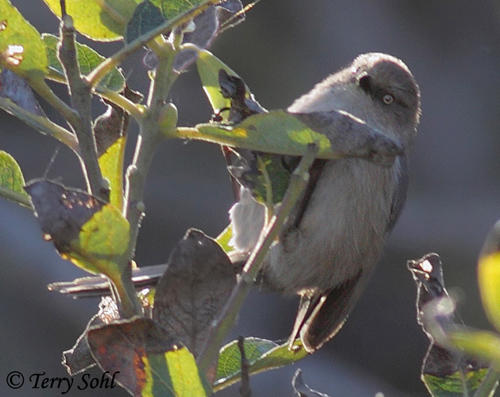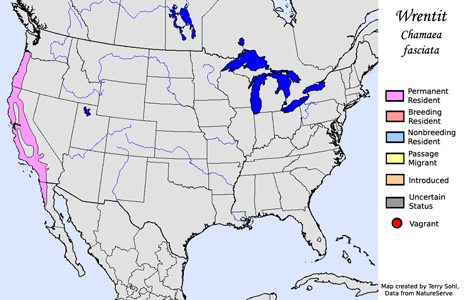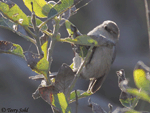Wrentit
Chamaea fasciata
| Length: 6.5 inches | Wingspan: 7 inches | Seasonality: Non-resident in South Dakota |
| ID Keys: Rather plain, grayish brown overall, long tail, pale iris | ||
 The
Wrentit is a distinctive species found near the Pacific Coast of the U.S.
and Baja California. They can be difficult to observe, given their
tendency to both nest and forage in dense shrubs and other vegetation.
Wrentits mate for life, typically bonding with a mate before or during their
first winter. Permanent residents throughout their range, the
remainder of their lives, Wrentit pairs inhabit remarkably small home ranges
of only a handful of acres.
The
Wrentit is a distinctive species found near the Pacific Coast of the U.S.
and Baja California. They can be difficult to observe, given their
tendency to both nest and forage in dense shrubs and other vegetation.
Wrentits mate for life, typically bonding with a mate before or during their
first winter. Permanent residents throughout their range, the
remainder of their lives, Wrentit pairs inhabit remarkably small home ranges
of only a handful of acres.
Habitat: Wrentits can be found in a variety of low, shrubby habitats, such as coastal sage-scrub, chaparral, riparian thickets, and shrubby gardens.
Diet: Feeds heavily on insects and spiders in the summer months. Insects are consumed at other seasons as well, but during the colder months, berries make up a big part of the diet.
Behavior: Actively feeds in dense, low vegetation, climbing and hopping through the vegetation, taking insects from the vegetation, often hanging upside down while feeding.
Nesting: The nests of Wrentits are built in dense shrubs, typically quite close to the ground (below 5 feet). The nest itself is built of barks, plant fibers, and spider webs, built in the shape of a small cup. Both parents incubate the eggs, and both parents help to raise the young.
Song: Song is a series of clear, crisp whistles, accelerating towards the end.
Migration: Permanent resident throughout its range.
Interactive eBird map: Click here to access an interactive eBird map of Wrentit sightings
Feeders: Will come to hummingbird feeders to take sugar water. They will also sometimes come to feeders for bread or other such baked goods.
Similar Species: Generally distinctive if well seen.
Conservation Status: There are currently no perceived major threats to Wrentit populations, and the IUCN cites it as a species of "Least Concern". Locally, populations may decline due to development of shrubland habitat.
Further Information: 1) Cornell's All About Birds - Wrentit
2) California Partner's In Flight - Wrentit
3) BluePlanetBiomes.org - Wrentit
Photo Information: December 9th, 2011 - Pacific coast of San Francisco - Terry Sohl
| Click below for a higher-resolution map |
 |
| South Dakota Status: Non-resident in South Dakota |
Additional Wrentit Photos
Click for a higher-resolution version of these photos

